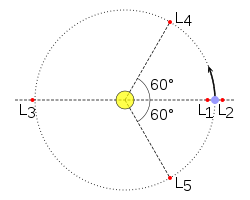List of objects at Lagrange points: Difference between revisions
→L2: Elliptical orbits are currently favored for the Constellation lunar relay satellites. |
|||
| Line 67: | Line 67: | ||
*future location of TDRS-style communication satellites to support L<sub>2</sub> satellite |
*future location of TDRS-style communication satellites to support L<sub>2</sub> satellite |
||
=== |
===Proposed objects=== |
||
In his book "[[The High Frontier: Human Colonies in Space|The High Frontier]]" Dr. [[Gerard O'Neill]] proposed the establishment of gigantic [[Space habitats|''Space Islands'']] in L<sub>5</sub>. The inhabitants of the [[L5 Society]] should convert Lunar material to huge [[solar power satellite]]s. |
In his book "[[The High Frontier: Human Colonies in Space|The High Frontier]]" Dr. [[Gerard O'Neill]] proposed the establishment of gigantic [[Space habitats|''Space Islands'']] in L<sub>5</sub>. The inhabitants of the [[L5 Society]] should convert Lunar material to huge [[solar power satellite]]s. |
||
Revision as of 21:46, 24 February 2009
This is a list of known objects which have been, are or are planned to occupy any of the five Lagrangian points of two-body systems in space.

L1
L1 is the Lagrangian point located approximately 1,500,000 km towards the Sun away from the Earth.
Past probes
- International Cometary Explorer, formerly the International Sun-Earth Explorer 3 (ISEE-3), diverted out of L1 in 1983 for a comet rendezvous mission. Currently in solar orbit, it may be captured in 2014 when it next approaches Earth.
- NASA's Genesis probe collected solar wind samples at L1 from December 3, 2001 to April 1, 2004, when it returned to Earth.
Present probes
- GGS WIND
- The Solar and Heliospheric Observatory (SOHO)
- The Advanced Composition Explorer (ACE)
Planned probes
Cancelled probes
- The Triana satellite, designed to monitor global warming.
L2
L2 is the Lagrangian point located approximately 1,500,000 km away from the Earth in the direction opposite the Sun.
Past probes
Present probes
Planned probes
- The joint NASA, ESA and CSA James Webb Space Telescope (JWST), formerly known as the Next Generation Space Telescope (NGST)
- The ESA Herschel Space Observatory
- The ESA Planck Surveyor
- The ESA Gaia probe
- The NASA Terrestrial Planet Finder mission (may be placed in an Earth-trailing orbit instead)
- The ESA Darwin mission
- The NASA Advanced Technology Large-Aperture Space Telescope, that will replace both the Hubble Space Telescope and JWST.
Cancelled probes
- The ESA Eddington mission
L3
L3 is the Lagrangian point located on the side of the Sun opposite the Earth, slightly outside the Earth's orbit.
- There are no known objects in this orbital location.
L4
L4 is the Lagrangian point located close to the Earth's orbit 60° ahead of the Earth.
- Dust clouds [1]
L5
L5 is the Lagrangian point located close to the Earth's orbit 60° behind the Earth.
- Dust clouds
- Spitzer is in an earth-trailing heliocentric orbit drifting away circa 0.1 AU per year. In circa 2013-15 it will pass L5 in its orbit.
Earth-Moon Lagrangian points
L2
- None
L4 and L5
- possible Kordylewski clouds
- future location of TDRS-style communication satellites to support L2 satellite
Proposed objects
In his book "The High Frontier" Dr. Gerard O'Neill proposed the establishment of gigantic Space Islands in L5. The inhabitants of the L5 Society should convert Lunar material to huge solar power satellites.
Sun-Mars Lagrangian points
Asteroids in the L4 and L5 Mars-Sun Lagrangian points are sometimes called Mars Trojan asteroids, but "Trojan asteroid", as originally defined, is a term for asteroids in the L4 and L5 Jupiter-Sun Lagrangian points.
L4
L5
- 5261 Eureka
- 1998 VF31, 2001 DH47, 2001 FG24, 2001 FR127 (not confirmed as true Lagrangian asteroids)
Sun-Jupiter Lagrangian points
Asteroids in the L4 and L5 Jupiter-Sun Lagrangian points are known as Jupiter Trojan asteroids or simply Trojan asteroids.
L4
L5
L4
L5
L4
L5
Sun-Neptune Lagrangian points
Asteroids in the L4 and L5 Neptune-Sun Lagrangian points are sometimes called Neptune Trojan asteroids, but "Trojan asteroid", as originally defined, is a term for asteroids in the L4 and L5 Jupiter-Sun Lagrangian points.
L4
Source: Minor Planet Center [2]
See also
References
Footnotes
